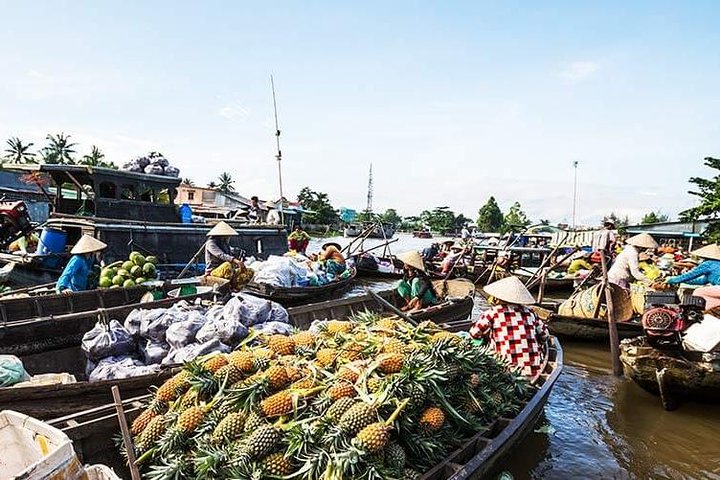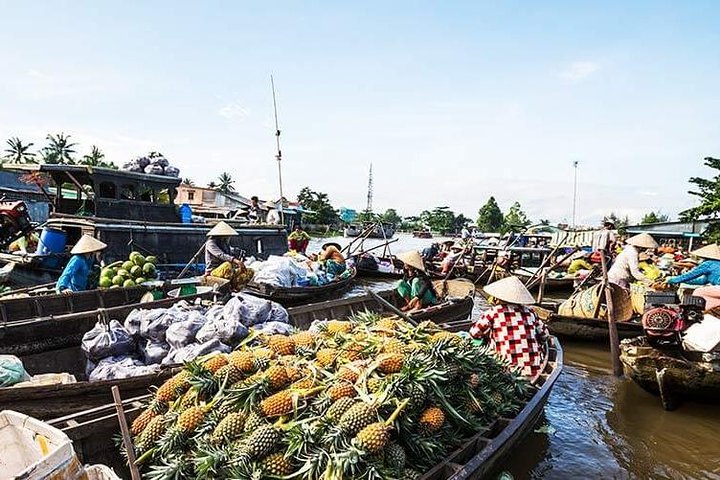Embark on a half-day private tour of the Cu Chi Tunnels from Ho Chi Minh City. Explore the underground world of guerrilla warfare, learn about the history of the war, and experience what it was like living inside the tunnel system. Don’t miss the chance to shoot iconic weapons and taste the cassava root that sustained Viet Cong fighters for years.
Embark on a half-day private tour of the Cu Chi Tunnels from Ho Chi Minh City. Explore the underground world of guerrilla warfare, learn about the history of the war, and experience what it was like living inside the tunnel system. Don’t miss the chance to shoot iconic weapons and taste the cassava root that sustained Viet Cong fighters for years.
- LỤA VIỆT - Silk is a natural protein fiber produced from the silkworm’s cocoon, and some forms can be woven into textiles. It takes around 3,000 silkworms consuming 104 kilograms of mulberry leaves to produce two pounds (one kilogram) of silk; the process lasts over three days. The result is a material that is lightweight, soft, and very…
- LỤA VIỆT - Silk is a natural protein fiber produced from the silkworm’s cocoon, and some forms can be woven into textiles. It takes around 3,000 silkworms consuming 104 kilograms of mulberry leaves to produce two pounds (one kilogram) of silk; the process lasts over three days. The result is a material that is lightweight, soft, and very absorbent, making it an ideal fabric for warmer countries. Silk was once considered extremely luxurious and thus available only to noble families. Now the fabric is widely used, and beautiful silk products are affordable to anyone. Be wary of buying silk for prices lower than that since they can be of questionable quality. A professional silk manufacturing enterprise that supplies silk not only to customers but also to designers in the Vietnam fashion market and also overseas. It exports fabric to Korea, Japan, Thailand, Denmark, France, England, and the U.S., so you are guaranteed the real thing here.
- Bến Đình - Leave the hustle and bustle of Ho Chi Minh City to explore one of the relics from one of the most significant local historical events in recent memory. The journey takes 2 hours west towards the Cambodian border. On the way to the Cu Chi tunnels, one can see local life in the area, both past and present. Learn about their lives, culture, and customs and get an insight into the recent past through local eyes. The location of the tunnels was of significant strategic importance: they are at the end of the infamous Ho Chi Minh Trail, and within striking distance of the southern Vietnam capital. Initial construction started in 1948 when the Viet Minh required somewhere to hide from French air attacks, and by 1965, the tunnel complex was estimated to consist of 200 km of tunnels. It included hospitals, schools, meeting rooms, kitchens, and sleeping quarters. Life was difficult for the inhabitants, and to protect against outside intruders, booby traps were laid throughout the complex.
- SƠN MÀI QUANG MINH - Handicap handicrafts factory: The high quality of resin from Vietnamese lacquer trees, notably those of the north, was a crucial factor in the rapid development of this art form. Decorated lacquer statues, panels, boxes, and trays may still be seen at many temples and pagodas. Over centuries, the use of lacquerware was extended to larger items such as wooden chairs and tables, decorated with engraved, painted, inlaid mother-of-pearl designs. By the 18th century, important centers for lacquerware production emerged in the north and in the south. As part of their strategy to open up Vietnamese handicrafts to new foreign markets, the French introduced formal training programs in lacquerware at the School of Indigenous Arts near Saigon from 1901 and in Hanoi from 1930. Since that time, lacquerware has continued to develop into one of the mainstays of the Vietnamese handicraft industry, both at home and abroad. Today’s most popular items include vases, jewel cases, desk sets, trays, and vertical blinds.

- Air-conditioned vehicle
- Bottled water & Lunch with traditional Pho Noodle Soup
- English speaking tour guide
- Ticket entrance fees
- Air-conditioned vehicle
- Bottled water & Lunch with traditional Pho Noodle Soup
- English speaking tour guide
- Ticket entrance fees
- Tips/ gratuities, personal expenses
- Tips/ gratuities, personal expenses
This is the ultimate Cu Chi Tunnels tour, taking you on a thrilling journey out of the city, zigzagging by car or van through Saigon’s bustling traffic. Dive deep into the history of the war from a Vietnamese perspective. Your first stop will be an outlet showcasing local products made from bamboo, a natural plant found along the Ho Chi Minh trails and…
This is the ultimate Cu Chi Tunnels tour, taking you on a thrilling journey out of the city, zigzagging by car or van through Saigon’s bustling traffic. Dive deep into the history of the war from a Vietnamese perspective. Your first stop will be an outlet showcasing local products made from bamboo, a natural plant found along the Ho Chi Minh trails and famously used during the Vietnam War. Next, you’ll pass through villages, rubber plantations, and rice paddies before arriving at the Cu Chi Tunnels. Here, you’ll get an immersive experience of what life was like inside the tunnel system, including a jungle walk to the National Sport Shooting Range to try out the famous rifles used during the war.
• Savor a delicious lunch of traditional Vietnamese cuisine (Beef Noodle Soup) after visiting a lacquerware factory where handicapped individuals, victims of Agent Orange, work daily.
- The remaining time is allotted for the travel time
- Using riffles is only applicable to those of legal age which is over than 18 years old
- Everyone can join this tour
For a full refund, cancel at least 24 hours before the scheduled departure time.
For a full refund, cancel at least 24 hours before the scheduled departure time.















